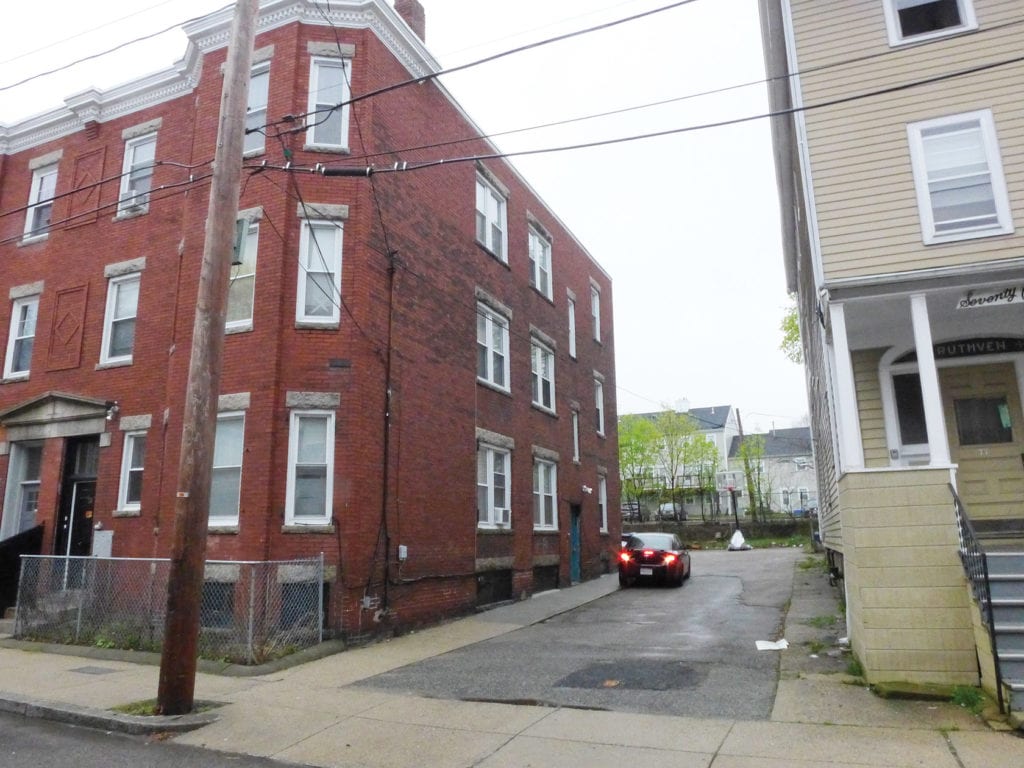Developers look to backyards for new housing units
Abutters decry loss of open space, increased density

When Cheryl Spence moved from New Jersey to Roxbury years ago, she was delighted by the neighborhood’s character and culture. Now, however, she fears that that personality she loved is in danger.
Spence, with other neighbors, is suing to prevent a nine-unit residential building from being built right next to her at 63 Moreland St., a vacant property which, at 4,000 square feet, can only fit five units, according to zoning regulations.
Around Roxbury, developers are proposing projects like this, squeezing in extra residential units in lots that require zoning variances because they are too small or have too little frontage on the street, in the name of creating enough and affordable housing, and crowding the neighbors that are already there.
“I’m not being greedy, I just want my space. Build something that’s in character with the neighborhood,” said Spence in a recent interview with the Banner. “People don’t want to live on top of each other, we want to live here.”
Just two blocks over from the Moreland Street project, another development proposal on Copeland Street has abutters suing as well.
The proposal would put another nine-unit building on what is right now a set of four smaller, vacant properties at the end of a long driveway hidden from the street, creating what is known in real estate as a “flag lot,” with the driveway as the flagpole and the property at the end of it. The dwelling would be placed right in the middle of six other current residential buildings, literally creating a home right in their backyards.
“Backyards are for kids to play in, not for developers to buy multiple parcels and stitch them together and basically build high end tenements,” said Spence, who has spoken with the abutters on this lawsuit due to its proximity to her own home.
Solomon Chowdhury, the owner of the property, declined to comment for this story.
A similar project also owned by Chowdhury, with a building being proposed in what is essentially abutters’ backyards, could happen nearby on Ruthven Street; meanwhile, the Dudley Square Neighborhood Association is arguing against a five-unit residential building at 11 Ruggles St., a site which is not zoned for residential use; and over at 14 Alaska St., developers could tear down a historic 1900s two-family home to create two three-story condo buildings with a total of nine two-bedroom units.
Angela Williams-Mitchell, a neighbor on Alaska Street, told the Banner that she and other abutters have gotten together to try to preserve the building, as they believe the development proposal would create parking issues and otherwise hurt the neighborhood.
“We are a community of families, and if you’re building two-bedroom units, it’s not for families,” Williams-Mitchell said. “It’s a little bit frightening, because I’ve had the experience of going to zoning board hearings, and when you think that something is not going to pass, that the voices of community will be heard, it has a totally different outcome.”
Williams-Mitchell is not the only Roxbury resident who has expressed disillusionment with the zoning board for siding with developers. Caroline Toth, a member of the Dudley Square Neighborhood Association, said that in her experience with the Zoning Board of Appeal (ZBA), the big developers who can afford real estate lawyers are the ones who are successful, while the small homeowners aren’t.
“The little guy, who’s doing some little project but needed approval, was getting turned away because they didn’t have a fancy attorney speaking the speak,” Toth said in a phone interview. “It’s a very weird dynamic.”
Spence, too, was involved in a similar case a few years ago, in which the board went with the developer’s proposal, and has seen other projects go through the zoning approval process as well.
“The fact is, the ZBA is appointed by the mayor, and what is the mayor’s goal? The mayor’s goal is 69,000 units,” she said, referring to Boston Mayor Martin Walsh’s Housing 2030 plan, which aims to create 69,000 new residential units across the city by 2030 to address the housing crisis. “He’s just greenlighting everything imaginable in Roxbury.”
The Mayor’s Office of Neighborhood Services and the Boston Planning and Development Agency declined to comment as the projects in question do not fall under their purview.
ONS has sided with the community on rare occasions. Toth told the Banner about a recent case in which a developer proposed a new building in the backyard of a series of historic row houses on Williams Street, seemingly without indicating to the ZBA that the property of the row houses had not been subdivided to allow such a project.
With the support of the Roxbury Historical Society and City Councilor Kim Janey, the DSNA was able to convince the Office of Neighborhood Services to oppose the project, stopping it from happening.
“I understand the city is under a lot of pressure to create housing. I get it,” Toth said. “But I don’t believe it should just be carte blanche to developers who are trying to make a fast buck. It just kind of tears up the integrity of the neighborhood.”






